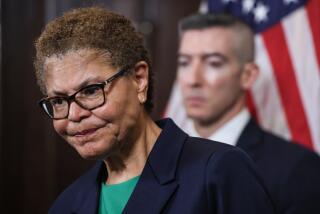S. Whittier Schools Eager to Cast Off Burden of Debt
- Share via
WHITTIER — South Whittier School Board member Joe Duardo remembers the shock four years ago upon being notified that his district was on the brink of bankruptcy, about to run out of money to pay its employees.
“It came like a bolt out of the blue,” said Duardo, then president of the school board. “We got a notice from the county office of education that there was no money . . . to back up the checks.”
Subsequent audits disclosed accounting errors that forced the district to get an emergency loan of $450,000 from the state and eventually repay nearly $1.1 million in various debts. The entire debt represented about 10% of the district’s $10-million budget for 1982-83.
The news will be better this week, when the district will be declared solvent at Tuesday night’s school board meeting--one year ahead of the recovery plan designed by state, county and local officials. The final payment of $112,500 was mailed to the state earlier this month.
“It’s like being on a diet,” said Supt. Richard Graves. “You make your weight. Now you’ve got to keep it off. Our problem is that we’re continuing our recovery because those areas that we did short, we’ve got to gradually bring back.”
Duardo, the only school board member who served through the entire fiscal crisis, said the recovery plan showed commitment by everyone in the district. “Through it all, we’ve come up with a much better system,” Duardo said.
R.F. (Rudy) Valdez, who served as superintendent from 1981-85, said he would advise superintendents to keep a closer eye on the books than he did. “It was a total shock,” Valdez said of learning about the money problems. “We bit the bullet and did what had to be done. . . . Getting out from under that debt is important because it was a good morale move for the district.”
Employees Were Angry
The comments now are proud and conciliatory, but it was not always that way. There was bad blood between the district and its employees in the 1983-84 school year, when there were no pay raises and six clerical and custodial workers were laid off. Unions representing the teachers and classified employees both passed votes of no confidence in the school board and picketed the district office.
Graves, then an assistant superintendent, remembers it as a difficult time.
“Once the community and the employees saw that the board was finding out what happened and was getting a plan together, that calmed the waters. But still, that feeling was there of, ‘How could you let this happen?’ ” Graves said.
School and employee union officials agree that employees, not students, were the victims of the budget cuts. The unions wanted some administrative positions to be eliminated rather than laying off janitors and clerical workers, but the district was legally obligated to honor the administrators’ contracts. “The people realized, too, that the money simply wasn’t there to have. There wasn’t really much we could do,” said Tommy Wootton, president of South Whittier Teachers’ Assn.
“I don’t think it hurt the students a great deal. The bigger hurt was in maintenance of the buildings,” he said, adding that roofing and broken glass sometimes went weeks without being repaired.
Corners Were Cut
The district has restored some maintenance services and rehired some workers, and employees received raises in the years after 1983-84.
Graves said that money problems kept the district from acquiring some new equipment. The district, which has an enrollment of about 3,500 students, also cut corners on utilities and the hiring of substitute teachers and classroom aides. Teachers were urged to be frugal with supplies, but Wootton said it never got to the point where teachers felt they couldn’t do their jobs.
“We took a dollar from here, $500 from there, and lo and behold we had enough because of our good internal controls,” Graves said of repaying the debt ahead of schedule. “It wasn’t the plan, but we knew that’s what the people wanted. We knew that’s what the board wanted.”
Robert Whitacre, the district’s assistant superintendent for business, said that overestimating income and then overspending budgeted accounts were responsible for the money problems. He said no individual was to blame, but former district Business Manager John Sugden resigned in August, 1983, just before he was to face a dismissal hearing before the school board.
The district has learned its fiscal lesson in the last few years, Whitacre said, and has improved its monitoring system by adding a budget committee and making monthly financial reports to the school board.
‘Much Wiser Now’
“We’re going to be conservative. We’ve gotten our fingers burned,” Whitacre said. “It was a horrible experience to go through. The board, the community and the management team are much wiser now. We don’t spend money before we get it.”
Whitacre said several debts came to light when the insolvency was first discovered in spring, 1983. The district borrowed $450,000 from the state Legislature in July, 1983, to be repaid in four installments of $112,500 beginning in the 1984-85 school year, plus $135,395 in interest.
The district also had miscalculated on another $314,000, part of the proceeds from the sale of Sunnyside School. That money was to have been repaid to the state, then given to the district in annual installments for maintenance. However, lawmakers allowed the district to keep the money in exchange for not receiving any maintenance money until August, 1986.
Other debts repaid to the state were $130,744 due to an error in estimating federal and state funds for special programs and $65,849 for the district being overcompensated for its child-care center.
More to Read
Sign up for Essential California
The most important California stories and recommendations in your inbox every morning.
You may occasionally receive promotional content from the Los Angeles Times.













